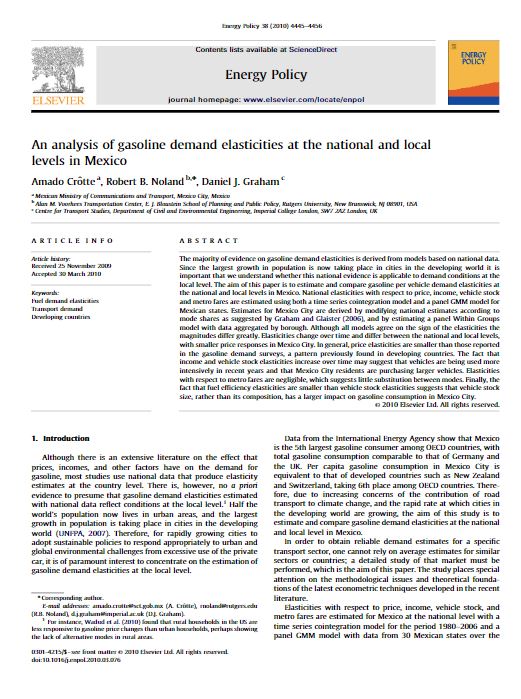Crôtte, A., Noland, R.B. & D.J. Graham. 2010, “An Analysis of Gasoline Demand Elasticities at the National and Local Levels in Mexico,” Energy Policy, vol. 38, no. 8, pp. 4445-4456.
Abstract
The majority of evidence on gasoline demand elasticities is derived from models based on national data. Since the largest growth in population is now taking place in cities in the developing world it is important that we understand whether this national evidence is applicable to demand conditions at the local level. The aim of this paper is to estimate and compare gasoline per vehicle demand elasticities at the national and local levels in Mexico. National elasticities with respect to price, income, vehicle stock and metro fares are estimated using both a time series cointegration model and a panel GMM model for Mexican states. Estimates for Mexico City are derived by modifying national estimates according to mode shares as suggested by Graham and Glaister (2006), and by estimating a panel Within Groups model with data aggregated by borough. Although all models agree on the sign of the elasticities the magnitudes differ greatly. Elasticities change over time and differ between the national and local levels, with smaller price responses in Mexico City. In general, price elasticities are smaller than those reported in the gasoline demand surveys, a pattern previously found in developing countries. The fact that income and vehicle stock elasticities increase over time may suggest that vehicles are being used more intensively in recent years and that Mexico City residents are purchasing larger vehicles. Elasticities with respect to metro fares are negligible, which suggests little substitution between modes. Finally, the fact that fuel efficiency elasticities are smaller than vehicle stock elasticities suggests that vehicle stock size, rather than its composition, has a larger impact on gasoline consumption in Mexico City.
